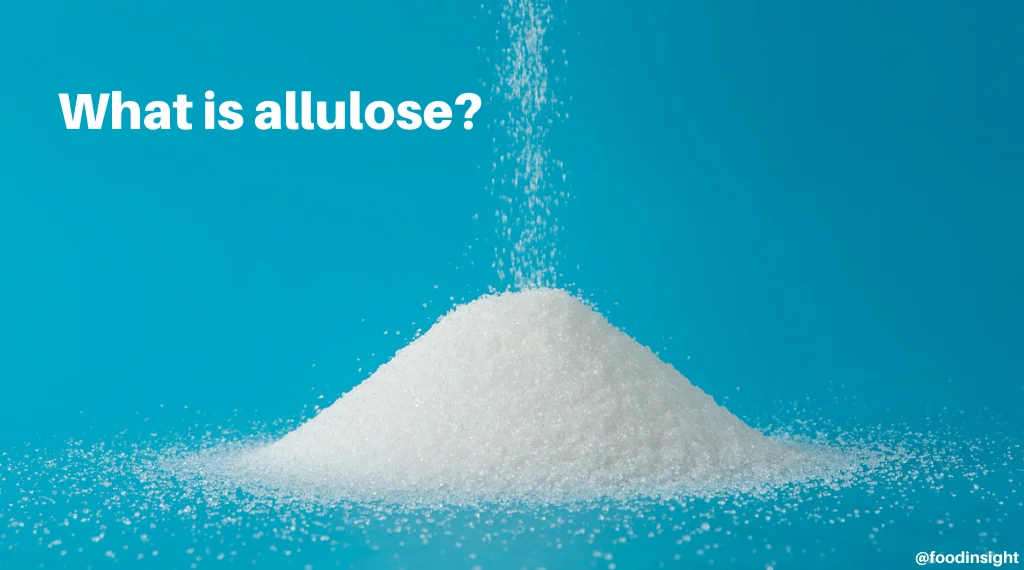
Highlights
- Allulose is a relatively new type of sweetener that many people have not heard of.
- Allulose is a naturally occurring sugar that is found in plant foods in very small amounts. It is also commercially produced from corn or fructose.
- Allulose is naturally low in calories. It contains about 10 percent of the calories of the same amount of table sugar and is about 70% as sweet.
- Allulose does not increase blood glucose and does not promote the growth of the kinds of bacteria in the mouth that cause cavities.
- Allulose is safe to consume and permitted for use in foods and beverages by the U.S. Food and Drug Administration (FDA).
When we think about sugar, most of us probably think about the same kind—the granulated kind used to bake cookies or sweeten coffee. But there are many different types of sugars—some of which many people are not familiar with. In a 2021 IFIC consumer survey, only 15% of consumers had heard of a type of sugar called allulose.
Where does allulose come from?
Allulose is considered a rare sugar because it is found naturally only in small quantities in plant foods such as brown sugar, maple syrup, wheat and dried fruits like figs and raisins. Allulose is also commercially produced, although it’s not as commonly used as other sugars in packaged foods and beverages or as a tabletop sweetener. This may change in the future, as scientists have only recently discovered ways to produce allulose on a larger scale by deriving it from corn or fructose.
How is allulose different from other sugars?
Sugars are known for their sweet taste. Allulose is about 70% as sweet as sucrose (also known at table sugar) but contains only about 10% as many calories. There are approximately 0.4 calories per gram in allulose, compared with four calories per gram in sucrose.
The amount and frequency of consuming sugars can increase our risk for developing dental cavities. But allulose is different in this regard. Because it is not metabolized in the mouth, allulose does not contribute to enamel erosion, nor does it promote the growth of oral bacteria that is associated with cavity formation.
Even though allulose is a type of sugar and its chemical formula (C6H12O6) is the same as fructose and glucose, allulose’s physiological impact is different from that of traditional sugars. Because of this difference, the U.S. Food and Drug Administration (FDA) has decided that allulose can be counted toward the grams of “Total Carbohydrate” on the Nutrition Facts label instead of “Total Sugars” or “Added Sugars.”
How is allulose digested?
Allulose is a monosaccharide—a single molecule of sugar—so there is technically no digestion that takes place after it’s consumed. Instead, allulose is rapidly absorbed by the body and is excreted intact. About 70% of the allulose we consume is absorbed by the small intestine and eventually leaves the body via urine, usually within 24 hours. The remaining 30% leaves the body after passing through the large intestine, usually within 48 hours. As a result of the way our bodies handle allulose, allulose does not increase blood glucose or insulin levels.
Due to its lack of impact on blood glucose, allulose has gained attention among those who follow a ketogenic (“keto”) diet, which restricts carbohydrate and sugar intake so that the body begins making and using a separate energy source called ketone bodies.
Is allulose safe to consume?
Allulose is safe to consume. The FDA has raised no questions or objections to four separate Generally Recognized As Safe (GRAS) notifications filed for allulose in 2012, 2014, 2017 and 2020.
GRAS is a regulatory review process used by the FDA to determine if scientific evidence and information about the intended use of a substance is widely known and that a consensus exists about its safety among qualified experts.
Stay close—there may be more to come on allulose!
Allulose is a relative newcomer to the food scene. It is not a common ingredient in packaged foods yet, but it is available in granulated and liquid forms as a tabletop sweetener. Stay tuned, as research on allulose and other rare sugars is only beginning to shed light on the role that these sugar alternatives can play in human nutrition.




